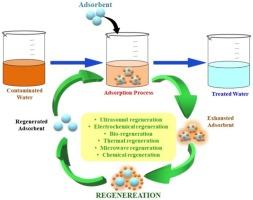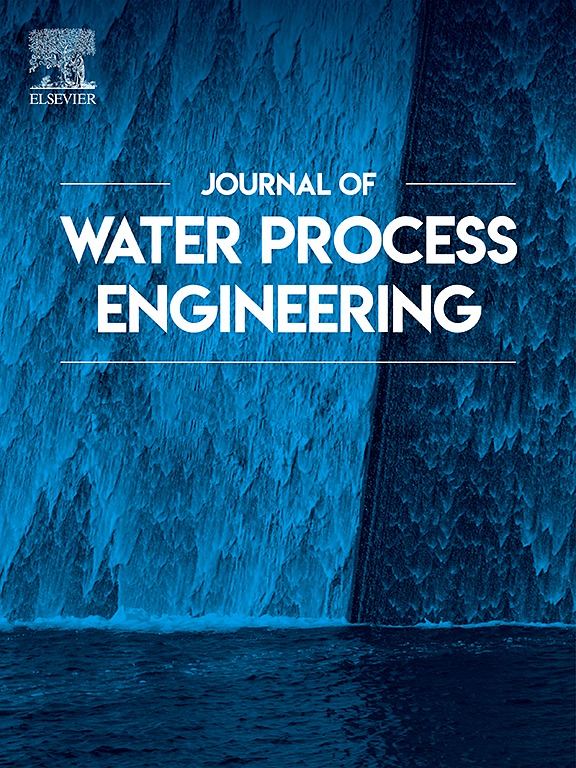水处理中使用的枯竭吸附剂的再生策略 - 综述
IF 6.3
2区 工程技术
Q1 ENGINEERING, CHEMICAL
引用次数: 0
摘要
处理废水以去除杂质的最常用、最可靠和最有效的方法是吸附法。废吸附剂的回收和可持续管理是吸附处理法去除废水中污染物的主要问题之一。废吸附剂的产生会造成二次污染问题。废吸附剂的再生和再利用可以缓解二次污染问题。除了吸附剂的高吸附性能外,废吸附剂的处理也是一个环境问题。将废吸附剂二次利用,用作催化剂、肥料、水泥基材料和生物燃料,无疑是保护环境和循环经济的好主意。本综述重点关注新兴吸附剂的有效性,以及如何回收、再生废吸附剂,并通过再利用或安全处置对其进行进一步管理。本文综述了各种再生技术,如超声再生、电化学再生、生物再生、热再生、微波再生和化学再生,这些技术都是为了更新用于消除污染介质中有机和无机污染物的耗尽吸附剂而采用的。此外,本综述还讨论了混合再生技术和耗尽吸附剂的二次利用。还讨论了在工业规模上利用这些再生技术的重要比较和未来展望。本文章由计算机程序翻译,如有差异,请以英文原文为准。

Regeneration strategies for exhausted adsorbents used in water treatment - A critical review
The most popular, dependable, and efficient method of treating wastewater to remove impurities is adsorption. The recovery and sustainable management of wasted adsorbents is one of the main problems with the adsorption-treatment method used to remove pollutants from wastewater streams. The production of spent adsorbents causes the secondary pollution problem. The regeneration and re-utilization of used adsorbents can be done to alleviate the secondary pollution problem. Aside from adsorbents high adsorption performance, the disposal of spent adsorbents is an environmental concern. Secondary use of spent adsorbents as catalyst, fertilizer, cementitious materials, and biofuels is definitely a good idea for environmental protection and recycling economy. This review focuses on the effectiveness of emerging adsorbents and how the spent adsorbents could be recovered, regenerated, and further managed through reuse or safe disposal. This article reviews the various regeneration techniques like ultrasound regeneration, electrochemical regeneration, bio-regeneration, thermal regeneration, microwave regeneration and chemical regeneration that have been performed for the renewal of exhausted adsorbents employed for the elimination of organic and inorganic contaminants from polluted media. Furthermore, this review discusses the hybrid regeneration techniques and secondary utilization of exhausted adsorbents. A critical comparison and future perspectives on the utilization of these regeneration techniques at industrial scale also discussed.
求助全文
通过发布文献求助,成功后即可免费获取论文全文。
去求助
来源期刊

Journal of water process engineering
Biochemistry, Genetics and Molecular Biology-Biotechnology
CiteScore
10.70
自引率
8.60%
发文量
846
审稿时长
24 days
期刊介绍:
The Journal of Water Process Engineering aims to publish refereed, high-quality research papers with significant novelty and impact in all areas of the engineering of water and wastewater processing . Papers on advanced and novel treatment processes and technologies are particularly welcome. The Journal considers papers in areas such as nanotechnology and biotechnology applications in water, novel oxidation and separation processes, membrane processes (except those for desalination) , catalytic processes for the removal of water contaminants, sustainable processes, water reuse and recycling, water use and wastewater minimization, integrated/hybrid technology, process modeling of water treatment and novel treatment processes. Submissions on the subject of adsorbents, including standard measurements of adsorption kinetics and equilibrium will only be considered if there is a genuine case for novelty and contribution, for example highly novel, sustainable adsorbents and their use: papers on activated carbon-type materials derived from natural matter, or surfactant-modified clays and related minerals, would not fulfil this criterion. The Journal particularly welcomes contributions involving environmentally, economically and socially sustainable technology for water treatment, including those which are energy-efficient, with minimal or no chemical consumption, and capable of water recycling and reuse that minimizes the direct disposal of wastewater to the aquatic environment. Papers that describe novel ideas for solving issues related to water quality and availability are also welcome, as are those that show the transfer of techniques from other disciplines. The Journal will consider papers dealing with processes for various water matrices including drinking water (except desalination), domestic, urban and industrial wastewaters, in addition to their residues. It is expected that the journal will be of particular relevance to chemical and process engineers working in the field. The Journal welcomes Full Text papers, Short Communications, State-of-the-Art Reviews and Letters to Editors and Case Studies
 求助内容:
求助内容: 应助结果提醒方式:
应助结果提醒方式:


